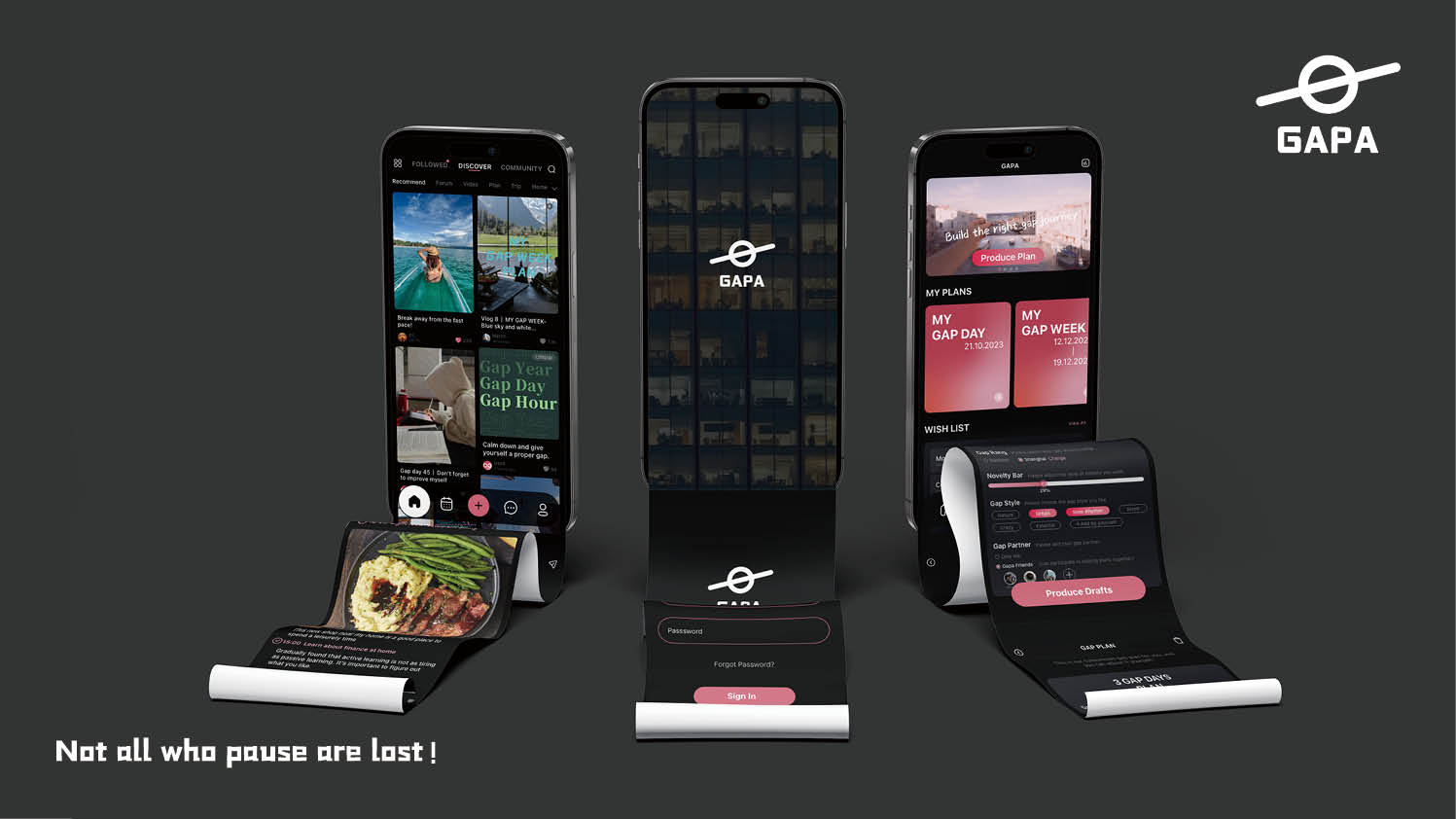
Gapa
A pause-for-growth app designed for young people — helping you decompress and reclaim your own rhythm during life’s “Gap” time.
October 2023|Shanghai · China
Introduction|
In today’s fast-paced and high-pressure society, young people struggle not only to balance work and life but also to acknowledge the right to pause. The Gapa project focuses on the shame and pressure surrounding the concept of a "Gap" period in the Chinese context, aiming to dismantle the negative stigma associated with it.
Through a structured and supportive platform, I hope to empower individuals with the agency to choose, express, and rebuild during their in-between moments—transforming pause from a symbol of failure into a vital opportunity for adjustment and growth.
A gap is not an escape—it is the courage to reflect, reorganize, and begin again.
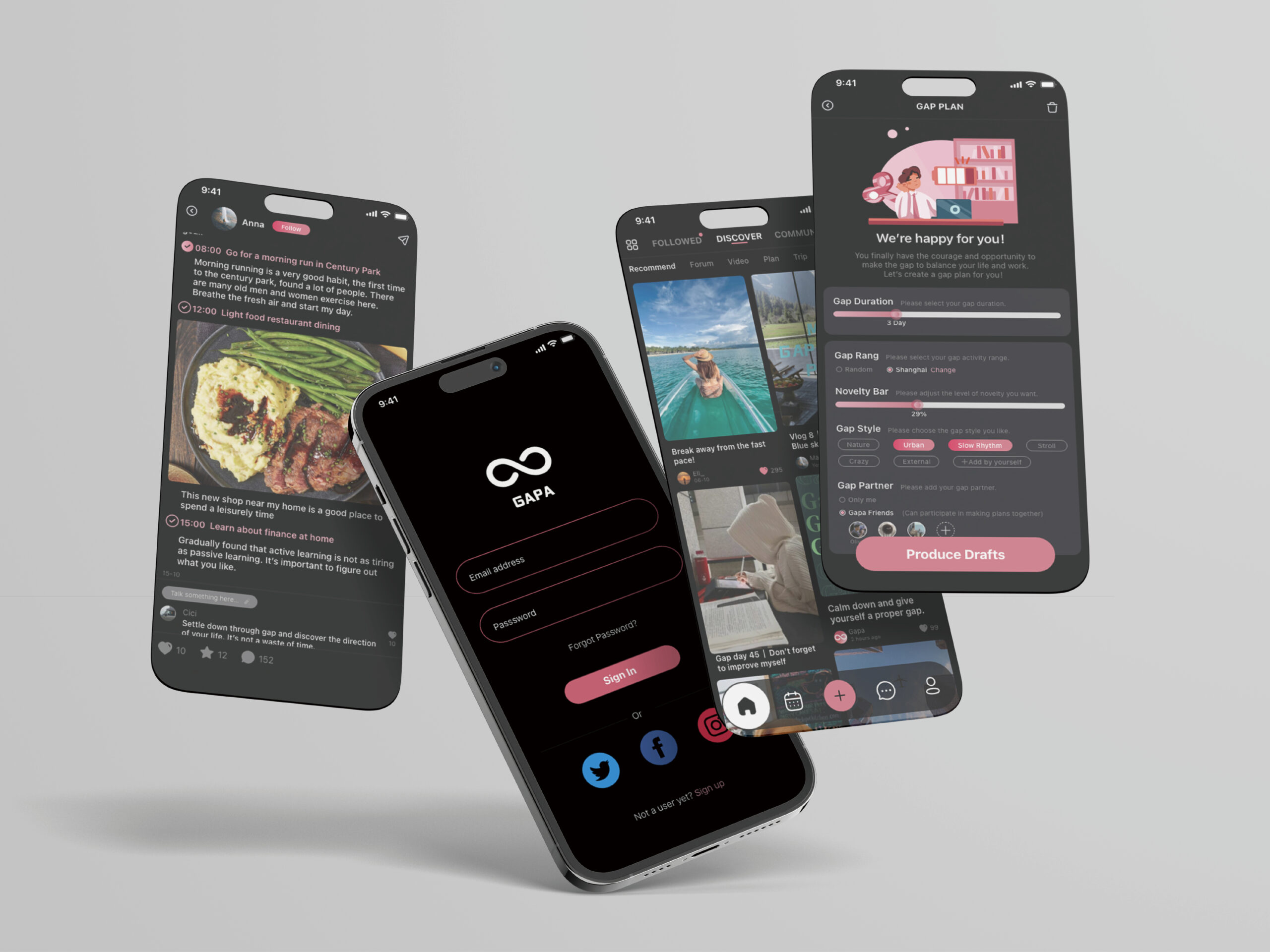
Design Key Words|Service Design / Emotional Rhythm Awareness / Emotional Tracking / Self-Care / Life Planning Support / Challenging Social Norms / Narrative Redesign / Cultural Reflection / Planned Pause
Project Background|
Cultural Differences between Chinese and Western Societies|
In Western societies, a Gap Year is widely recognized as a legitimate phase of personal development—an opportunity for self-exploration, social engagement, or emotional recovery. In contrast, within the Chinese context, “gap” is often misinterpreted as laziness, avoidance, or a sign of falling behind. There is little social tolerance for intentional pauses, and individuals often lack the structural or emotional support to navigate such in-between periods.
Social Observation|
As illustrated, the life trajectory for most young people in China follows a highly linear structure: Gaokao → University → Employment → Marriage. Any deviation from this track—such as taking a gap—can easily be seen as a sign of laziness or failure, leading to immense psychological and social pressure.
In the Chinese context, the word “gap” is often associated with idleness, burnout, or stagnation. Even when individuals genuinely long for a break, many are hesitant to express it or act on it. As several interviewees noted: “Resting makes me feel guilty” and “I can’t explain to my parents why I’m not working.”

Internet Meme|
Buzzwords like “Gap Day” and “Gap Hour” are trending across Chinese social media platforms. While they may appear lively on the surface, they reflect a deeper absence—the reality that a true, extended gap is still socially unacceptable, forcing people to seek comfort in micro, fragmented moments of rest.
Ironically, even those who do choose to take a gap often feel pressured to turn it into a performative lifestyle—constantly posting updates, curated content, and check-ins to stay visible on social media. As a result, their so-called break becomes more exhausting than their actual workdays.
This phenomenon is both a critique and a signal of the times: a growing awareness that pausing is not indulgence—it’s increasingly essential, yet structurally unsupported.

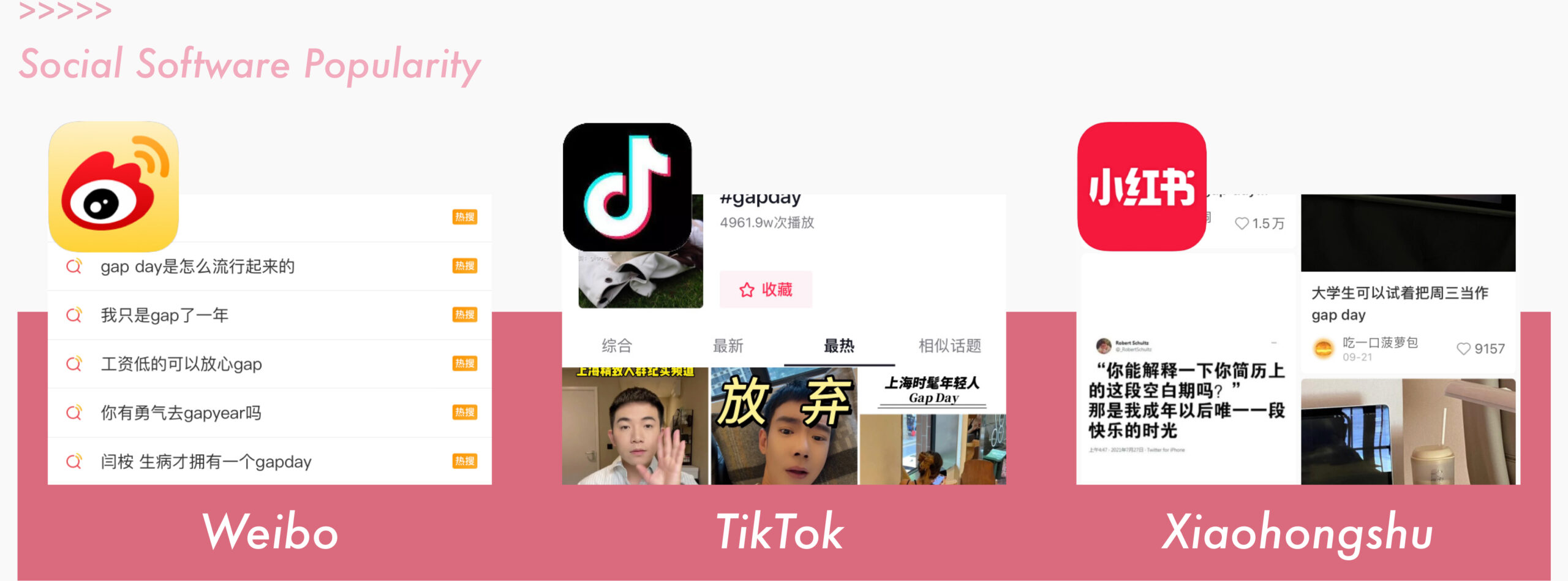
User Research|
This project conducted user research through two primary methods, focusing on participants’ perceptions of “gap,” behavioral patterns, and emotional fluctuations during transitional periods.
In-depth Interviews: One-on-one, open-ended interviews were conducted with five individuals from diverse professional and life backgrounds. These conversations explored their current life states, work-related challenges, emotional struggles, and both real and imagined understandings of what it means to take a “gap.”
Emotional Diary Tracking: All five participants took part in a one-week “emotional tracking” exercise. Using a combination of visual entries and mood line graphs, they recorded daily shifts in emotional states—capturing exhaustion, anxiety, burnout, and moments of relief in a visualized format.
Note: To protect participants’ privacy, no real personal photos are shown on this site. Instead, we focus on presenting key interview quotes and insight summaries.

Common Challenges Identified:
Inability to pause proactively:
Most users lacked emotional regulation tools and did not have an internalized sense of legitimacy around taking a break.Guilt-driven restlessness:
Rest often triggered feelings of guilt, making users even more anxious during their supposed downtime.Performative gap behavior:
Many felt pressured to document and share their “gap” experiences on social media, turning the break into yet another exhausting performance.Lack of personal rhythm:
Instead of recovery, the gap became a checklist of things to accomplish—losing its original intention of restoration.
Pain Point Analysis|
Key Pain Points
Lack of gap awareness
Lack of guidance and planning tools
Emotional and social constraints
Design Opportunities
Provide personalized support systems
Build a community-based interaction system
Guide users through a structured gap journey
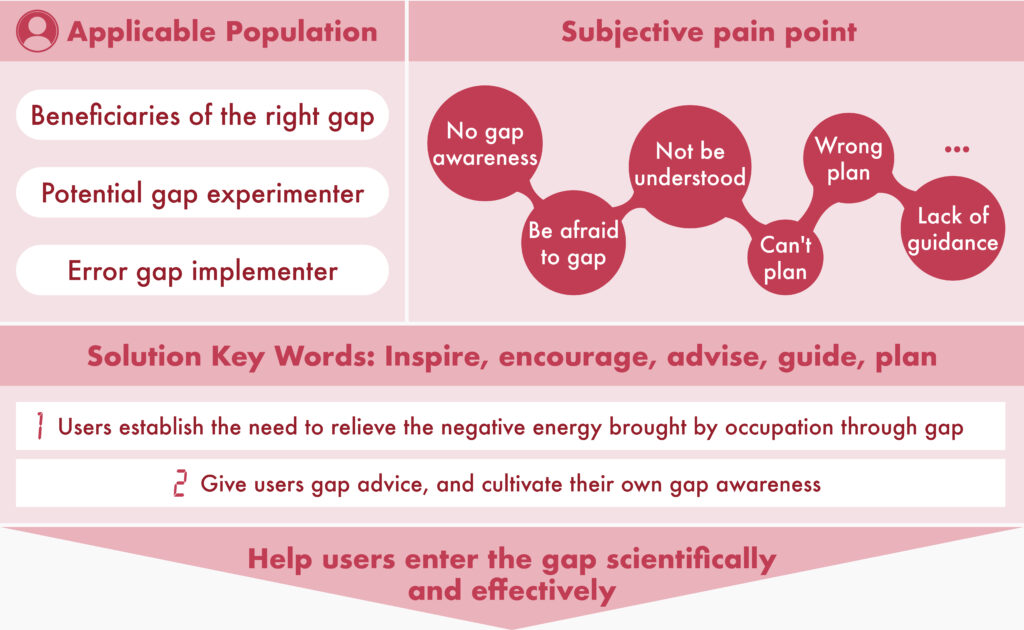
Concept Development|
Gapa is not a conventional productivity or rest management tool. It is a “socialized pause system” designed around user motivation, cognitive stages, and social contexts. The concept is built upon four key development layers:
User Segmentation Logic
Based on user research, the platform identifies four distinct user groups:
Experienced Users: Have taken a gap before, with high awareness and planning ability
Willing Users: Hope to take a gap but lack clear pathways or confidence
Failed Users: Attempted a gap but encountered obstacles or social resistance
Unaware Users: Have little to no concept of a gap and are bound by mainstream expectations
The system aims to leverage content and interaction from experienced users to inspire, guide, and support the other three groups.
The Four-Stage Gap Growth Path
The conceptual model is structured around a progressive, guided journey:
Stage 1: Awareness Building
Through curated browsing, content recommendations, and light community interaction, users gradually form an understanding and acceptance of “pause” as a valid life strategy.Stage 2: Motivation Formation
The system tracks usage behavior to surface patterns and pain points, helping users identify personal rhythms and motivations for taking a gap.Stage 3: Plan Generation & Execution
Using AI-powered suggestions combined with user input, the platform helps co-create gap plans with reasonable goals and actionable steps.Stage 4: Sharing & Reframing
Users are encouraged to share their experiences within the community, completing the cycle from personal practice to collective meaning-making.
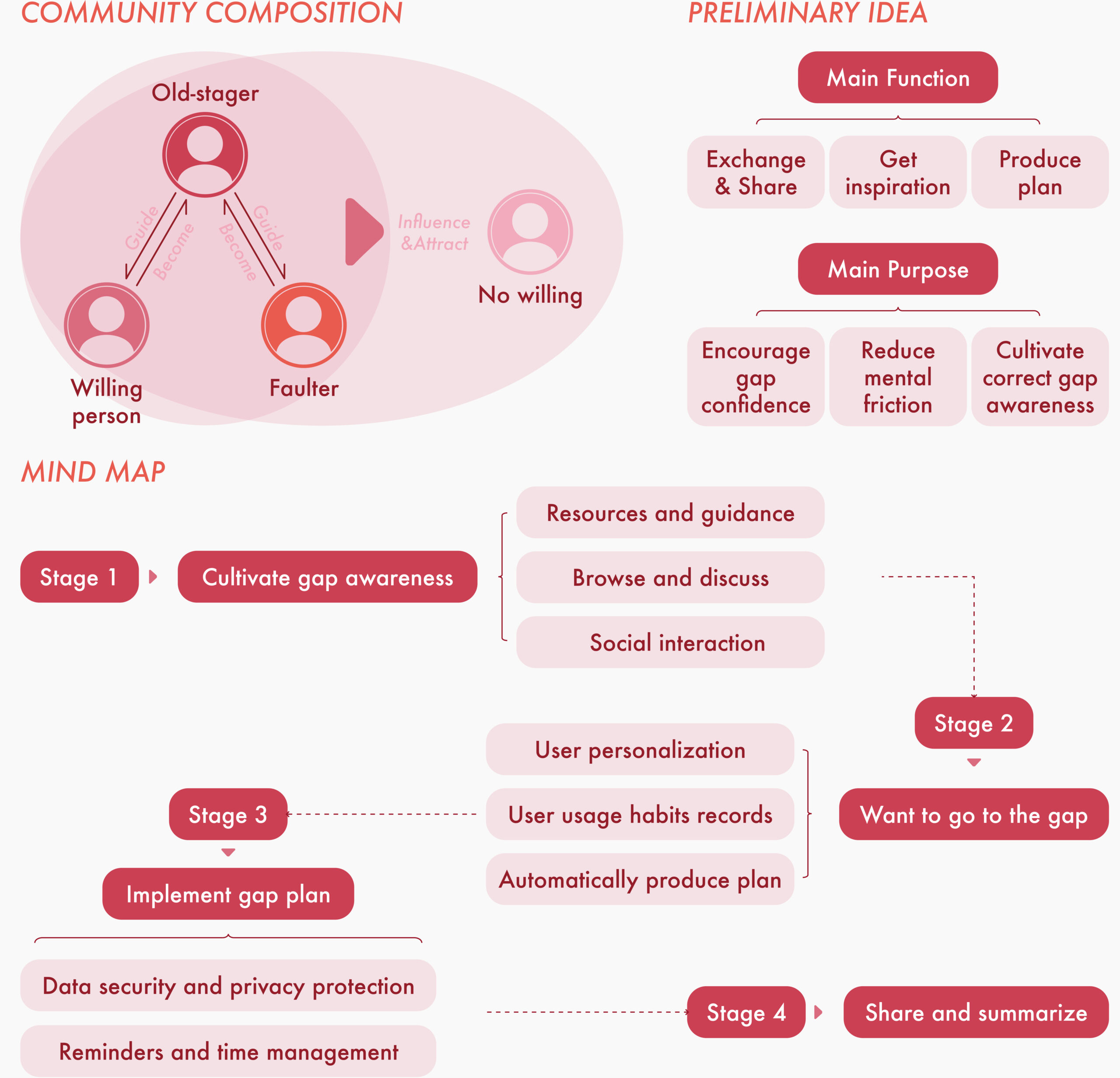
User Experience Flow Iteration|
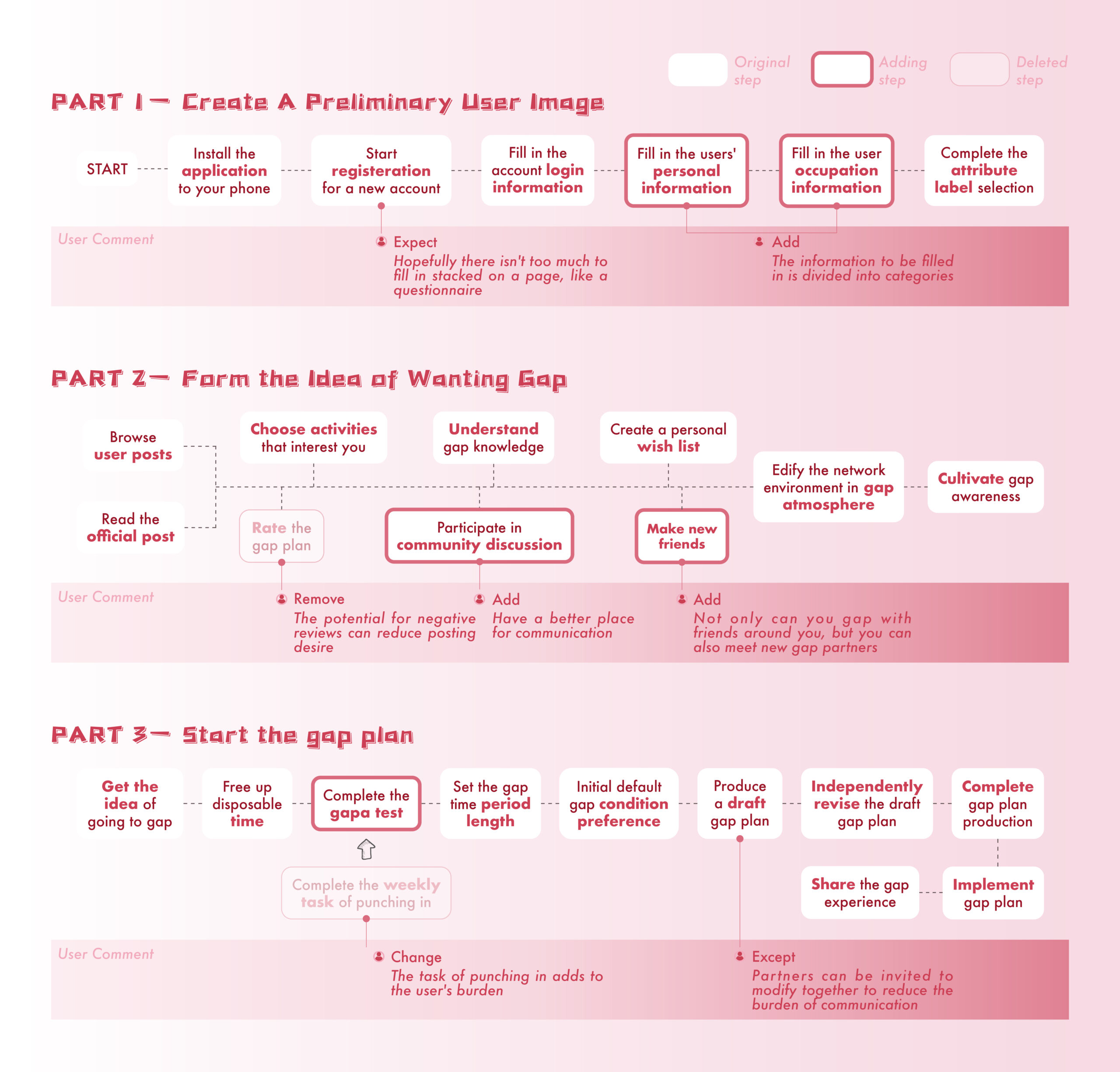
Lo-Fi Wireframe|
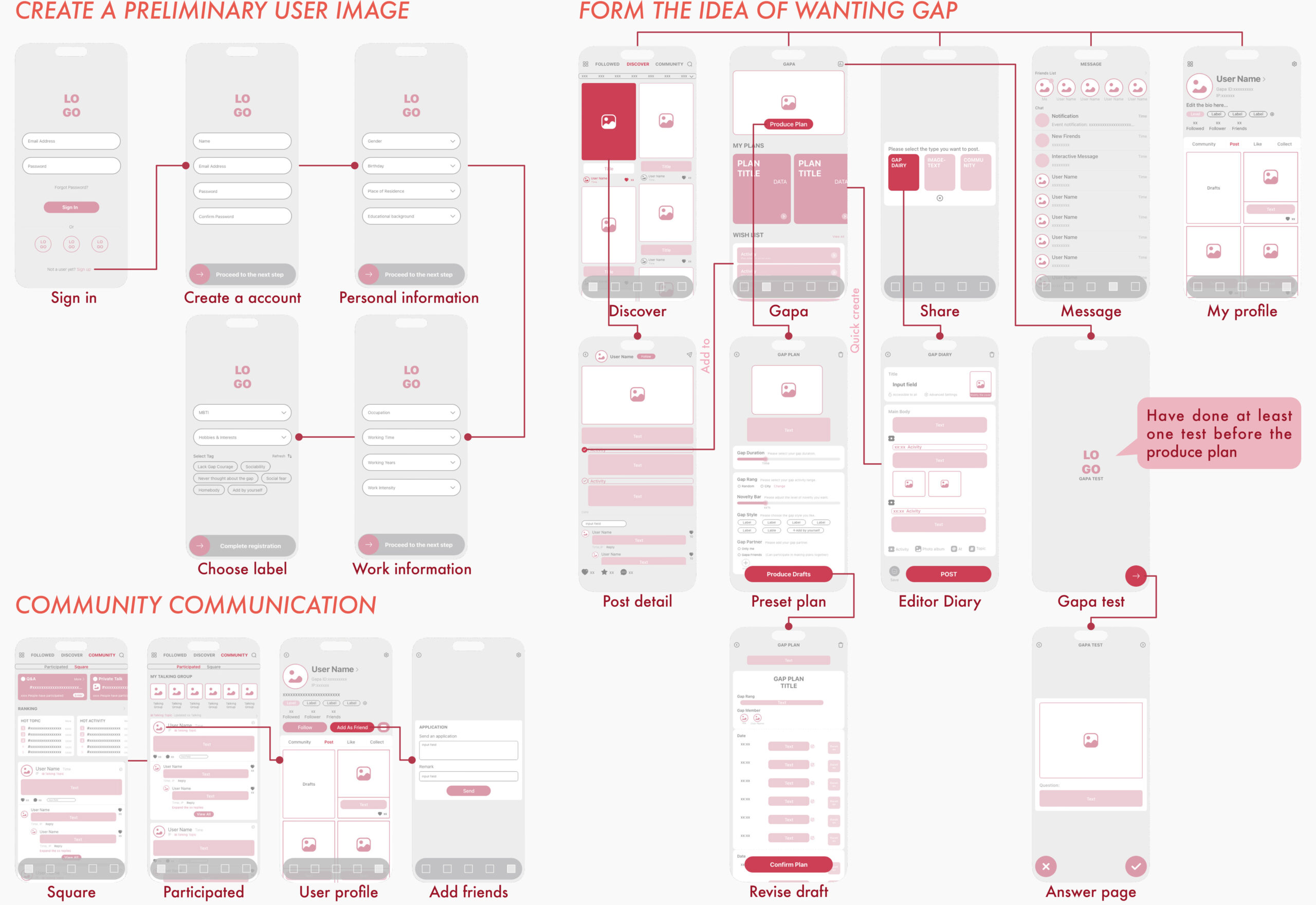
UI Design and Visualization|
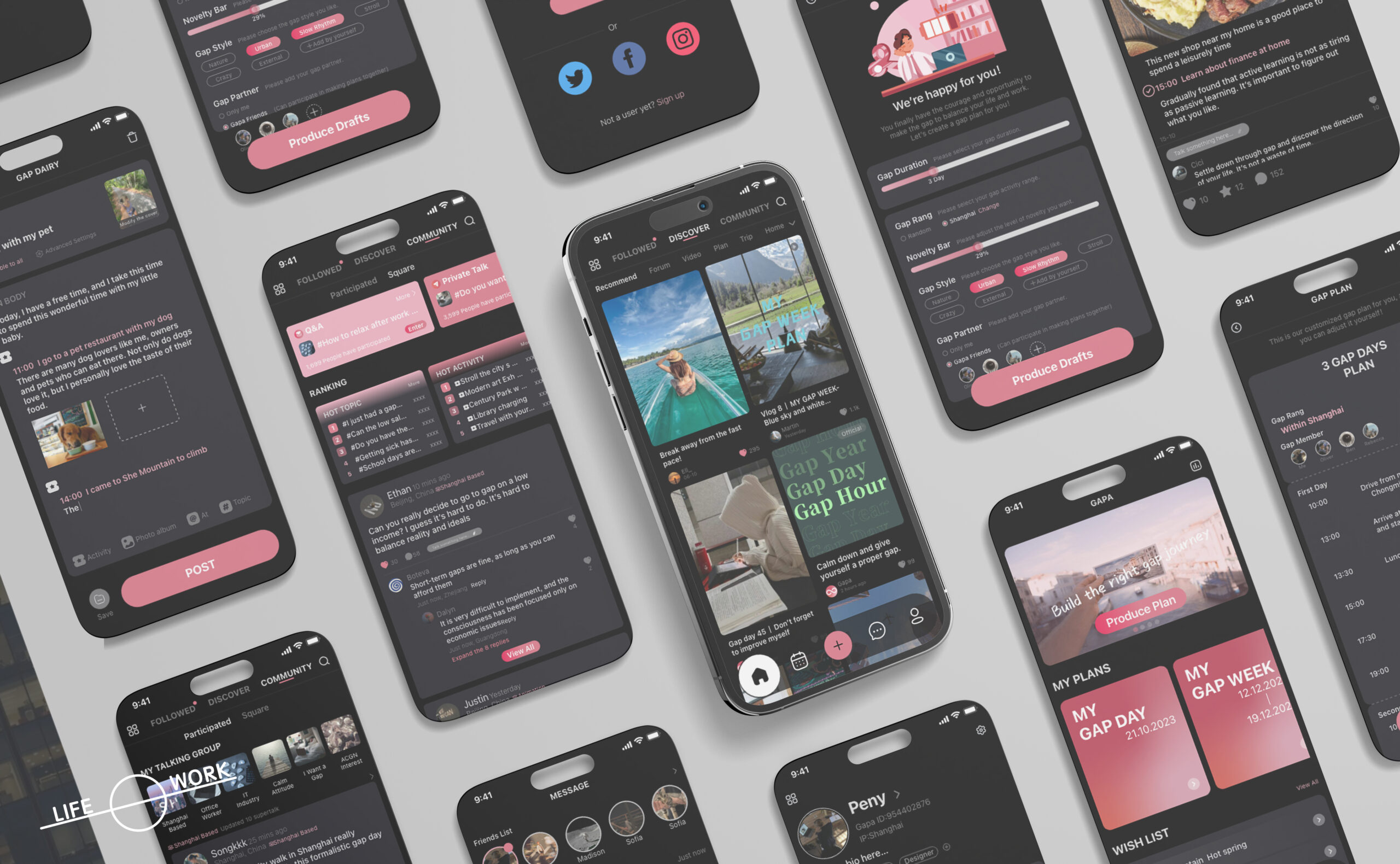
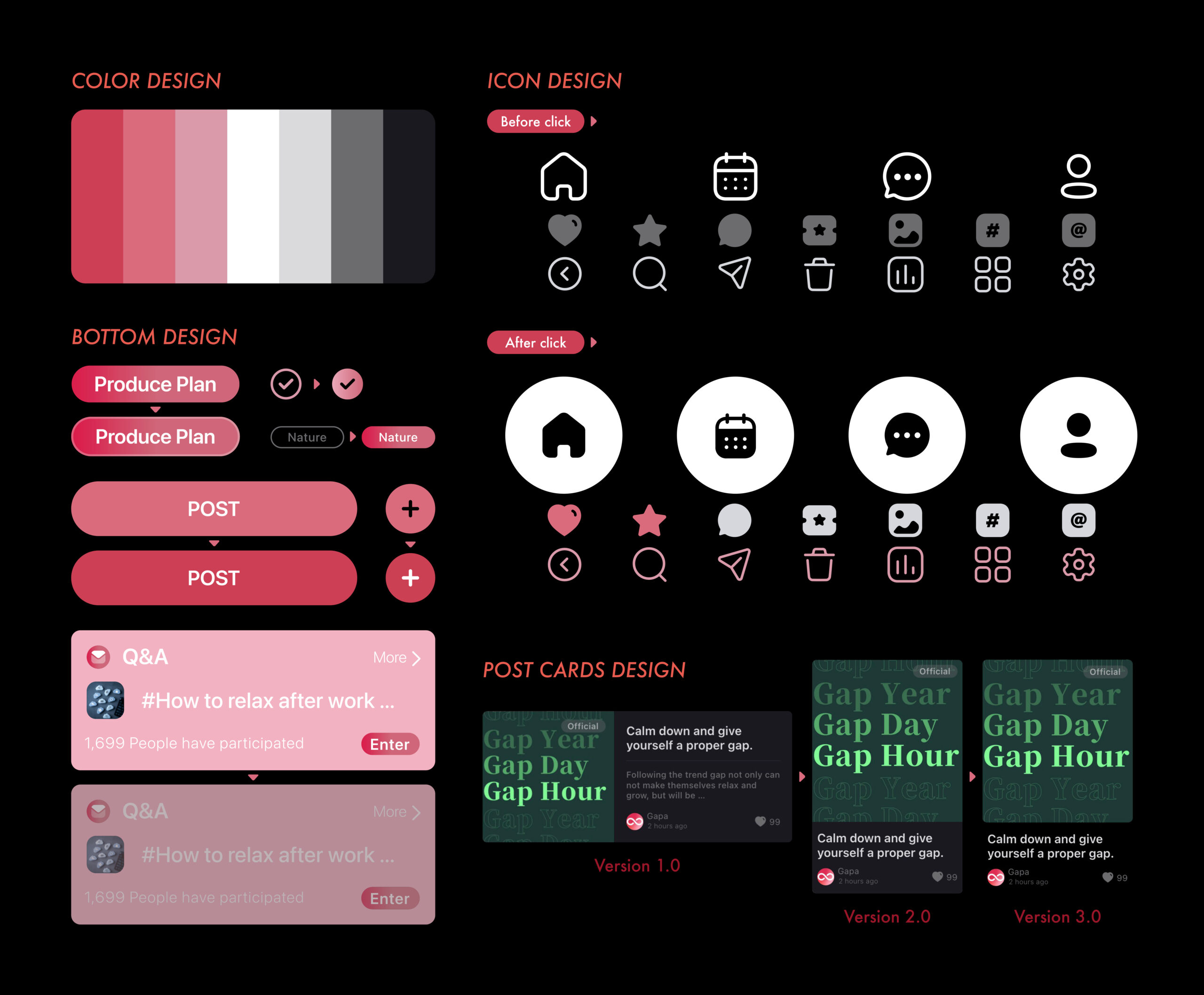
Download of Project Documentation|
Gapa Comms Package
You're welcome to download the full Gapa Project Comms Package. It includes a comprehensive overview of the project, design rationale, user research insights, system diagrams, UI showcases, and visual outcomes—ideal for portfolio presentations, project reports, and external sharing.
End|
In a time when pause should be a natural part of life, it’s becoming harder than ever to truly stop.
Gapa doesn’t attempt to define how users should live—it offers a gentle, flexible support system that helps them tune into their inner needs, regain agency, and redesign their own rhythm. It responds to invisible exhaustion, unspoken requests for rest, and a long-neglected structural right to breathe.
In the face of rigid social structures and identity expectations, I hope Gapa proposes a different possibility: Rest is not withdrawal—it’s reconstruction; A gap is not giving up—it’s reconnecting.
This project may not be perfect, but it hopes to be a genuine beginning.
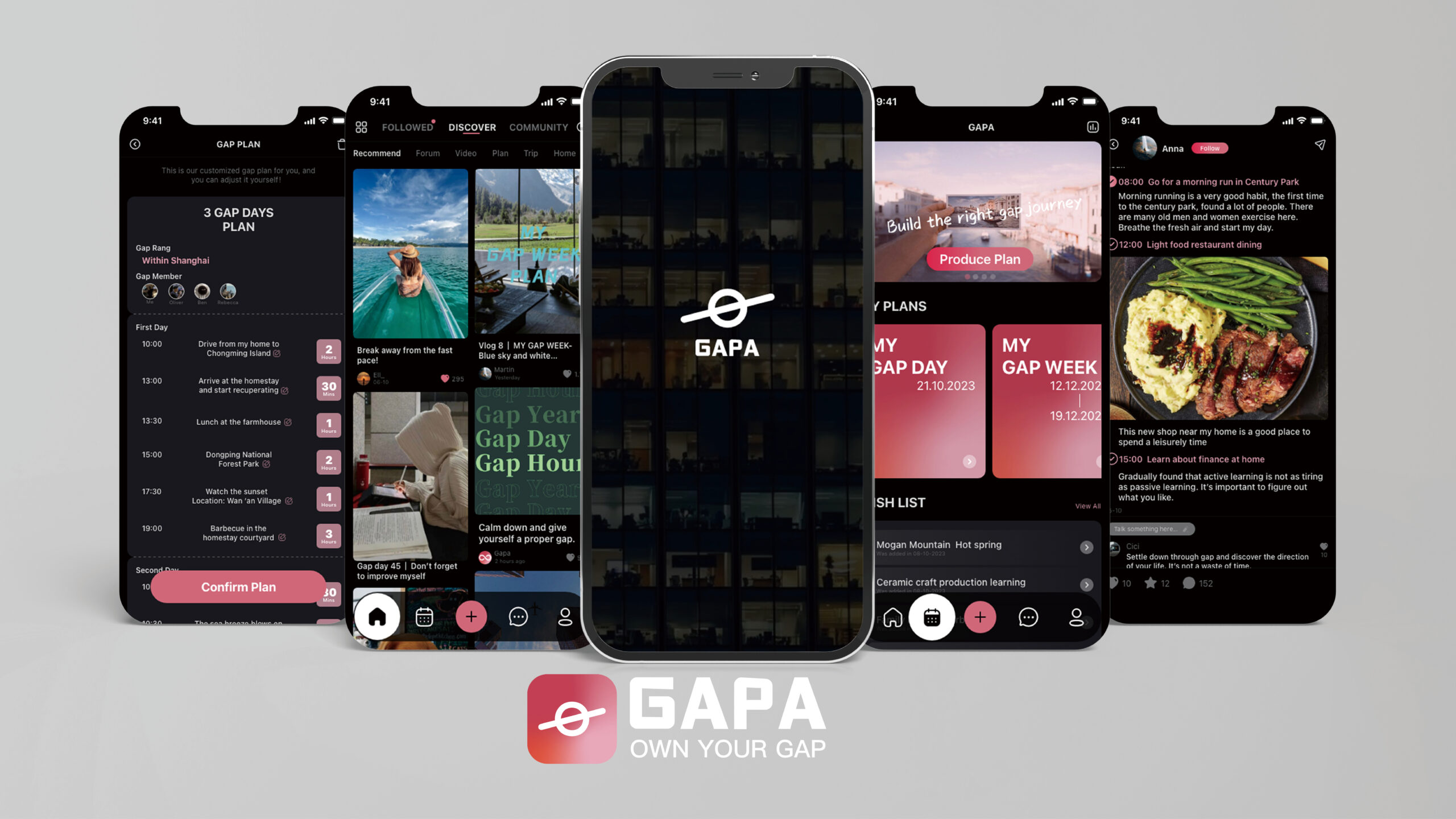
If this project resonated with you, or you’d like to collaborate — I’d love to hear from you.
📧 Email: [email protected]
📸 Instagram: har_rison0525